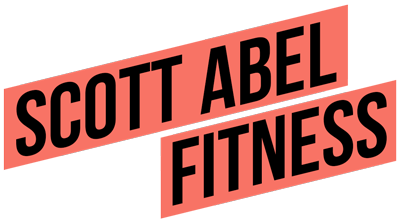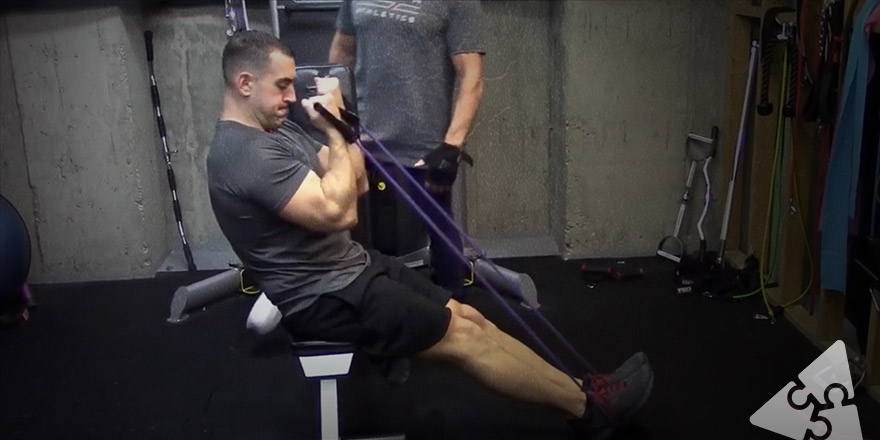One of the most effective ways to build bigger and better developed arms is to superset biceps and triceps.
This has been a tried-and-true method for arms training almost since Eugene Sandow, but many trainees have a problem doing supersets or training complexes in busy gyms.
Sometimes there is a solution for these issues, and sometimes not.
I’ve come up with several ways to work around crowded gyms where you may not feel comfortable occupying more than one piece of equipment at a time, or it just isn’t feasible to even try to do so.
The Toolbox: Resistance Bands (RBs)
The best craftsmen have many tools in their tool box, but at the same time, you need to know when and how to use each tool. Your training toolbox works the same way. In this case, training with resistance bands eliminates a need to occupy a lot of space or common equipment, but doing so still gives you an effective solution to training problems of weak bodyparts or sticking points where you need to add in supersets, complexes, or similar-type work.
(Also, it doesn’t have to be “either/or.” Depending on your own training situation, you can pump rubber along with pumping iron.)
For arms training, we need to begin, first, with an understanding of the main functions of the two muscle antagonists of the arms: flexion (biceps) and extension (triceps). Then, we need to combine the simplest but most effective exercise and reps combinations in order to induce the most effective adaptive response.
Like any great training protocol, understanding muscle function and the reps curve for effective hypertrophy takes us most of the way to getting the most out of our targeted training for muscle development.
Beyond that, what I think of as “next level” training means manipulating muscle function in a variety of gravitational planes in order to recruit more muscle fibers. This is a fundamental principle of innervation training. (You can read about it in my book or in my free Innervation Primer.)
The “Pumping Rubber” Arm Blast
for new biceps/triceps growth and development
| Circuit One | |
| 1a) Seated Alternate DB Curls (or Heavy BB Cheat Curls) | 3-4 X’s 6-8 EA |
| 1b) RB Bent Over Triceps Pushdowns | 3-4 X’s 15-20 |
| 1c) RB standing horizontal pull-a-part extensions | 3-4 X’s 15-20 |
| 1d) RB lying triceps extensions (or RB 2 arm triceps kickbacks) | 3-4 X’s 15-20 |
| Circuit Two | |
| 2a) Seated DB Triceps French Press (or BB Close Grip Bench Press) | 3-4 X’s 6-8 EA |
| 2b) RB Two Arm Angled Biceps curls or horizontal angle biceps curls | 3-4 X’s 15-20 |
| 2c) RB Two Arm Standing Curls (supinated, thumbs pointing out) | 3-4 X’s 15-20 |
| 2d) RB Two-Arm Standing Cross Chest Curls (pronated, palms face thighs) | 3-4 X’s 15-20 |
★ Note that all of the above are post-warmup working sets, not total sets.
Performance:
- For all the exercises above, you choose a weight (or resistance band tension level) that challenges you for the reps called for but you never train to failure.
- Perform the exercises in each sequence (from “a” to “d”) with virtually no rest between each station. After completing exercise “d” in the sequence, you rest as you typically would between working sets of an exercise in a workout. When you can subjectively assess that you can perform the next set with equal intensity to the previous set, then proceed to the next set. Once you have completed all the working sets (either 3 or 4) for sequence #1 – then rest, and proceed to sequence #2 and repeat the “a” to “d” sequence as you did for sequence #1.
- The first exercise in each sequence is all about emphasizing “load” but you are still concentrating on choosing a weight that challenges you for those reps without losing good form. Don’t use momentum. Use proper form.
- For the higher reps resistance bands exercises that follow the first exercise in each sequence, you want to think about ‘continuous tension’ and a good pumping reps cadence. You will find Resistance Bands are excellent for inducing a peak contraction in so many exercises as well.
- As an added bonus, RBs exercises tend to put a lot less strain on the joints, which is an extremely appreciated advantage in older trainees.
Discussion
What you see here is an amazing way to combine traditional barbell and dumbbell work with resistance bands in order to produce a non-traditional adaptive response.
The first exercise in each sequence is a heavy low reps exercise. First it’s for biceps in sequence #1, and then it’s for triceps in sequence #2. Then, in both sequences we follow that up with three exercises with higher reps and with resistance bands.
You’ll also notice that we use a range of planes of motion in order to change and alter the gravitational forces acting on the biceps and triceps. This influences muscle fiber recruitment.
For example, in the first sequence, the heavy biceps exercise is floor-to-ceiling—a vertical emphasis. Next, that first triceps exercise is also vertical, but it’s more ceiling-to-floor. This is followed by a horizontal plane exercise (the pull-a-parts) and then a vertical plane that is back to floor-to-ceiling.
| 1a) Seated Alternate DB Curls (or Heavy BB Cheat Curls) |
3-4 X’s 6-8 EA | Vertical Floor-to-ceiling |
| 1b) RB Bent Over Triceps Pushdowns | 3-4 X’s 15-20 | Vertical Ceiling-to-floor |
| 1c) RB standing horizontal pull-a-part extensions | 3-4 X’s 15-20 | Horizontal |
| 1d) RB lying triceps extensions (or RB 2 arm triceps kickbacks) | 3-4 X’s 15-20 | Vertical Back to floor-to-ceiling |
In the second sequence, the heavy triceps exercise is again a vertical plane to begin with, and then this is countered by the first antagonist high reps exercise for biceps to be in a more horizontal plane.
| 2a) Seated DB Triceps French Press (or BB Close Grip Bench Press) | 3-4 X’s 6-8 EA | Vertical Floor-to-ceiling |
| 2b) RB Two Arm Angled Biceps curls or horizontal angle biceps curls | 3-4 X’s 15-20 | Horizontal |
By combining a heavy low reps exercise with a sequence of high reps resistance band “pumping” exercises you get a form of muscle stimulation that is difficult to duplicate in other ways; and you will most certainly feel that difference. Muscle growth is all about being able to “feel” a great mind/muscle connection of working muscles. This sequence facilitates that connection.
Also, when you look at the first and second complex together, you see a minimum of 60 reps done for both muscles: biceps and triceps. This is 120 reps of arm work! And that’s when doing just the minimum. If you do the 4 sets and the highest reps range suggested you get 112 reps for biceps and 112 reps for triceps—a maximum of 224 total reps of arms work.
Also, it’s not just that this is a lot of arm work; it’s a lot of extremely effective arm work and that is what matters.
When/How to Use This Sequence:
I originally designed this sequence to help clients who needed a way around the limitations of a crowded gym, where using multiple sets of equipment (dumbbells, this cable machine, that cable machine, etc.) isn’t very polite.
Obviously, that’s not the only scenario you can use it.
The easiest, simplest application for this sequence is to just substitute these two complexes for arm day for about 4-6 weeks. You have to devote enough time to a new training stimulus in order for it to generate the desired adaptive response. So, if you choose this option then you definitely want to perform the full 4 sets of each sequence.
Other trainees who really want to focus on arms development can employ this sequence as an added arm workout at the end of leg day or shoulder day, as long as those days are separate from your actual arm workout day by at least three days. If you are choosing this option, then you would only perform three sets of each sequence, and only do this for about three weeks at a time as an added arms training stimulus; otherwise you will overtrain the arms in short order. (In other words, go 3 weeks on, 3 weeks off.)
This is also a great biceps/triceps training option when traveling and maybe having to use a hotel gym with limited equipment. Remember, resistance bands weigh virtually nothing and they are easy to pack in your gym bag OR in your luggage. When you take resistance bands with you, you have a gym on you wherever you go. If you do this, just remember to stick to the reps schemes. (I.e., you want to hit low reps first, then high reps in the succeeding sets.)
That being said, I do admit I really like that combination or iron and rubber; the combination of heavy low reps iron, pumping along with high-reps rubber is something you have to feel to truly appreciate and understand. One of the nice things about arms training is that you can hit low-reps iron without needing dumbbells going all the way up to 100 lbs or something—for arms, a set of dumbbells going up to 50 lbs. will be more than enough to get into that lower-rep range for a lot of people.
What you will learn from applying this sequence for 4-6 weeks, is that “just lift heavier weights” is not the only solution to every training problem of stubborn bodyparts or stalled progress; and, sometimes “just lift heavier weights” is not a solution at all. (Sometimes… well, it fits the definition of insanity.)
Pump some rubber, combine it with pumping iron, and you can reignite new growth, and you can have fun doing so!
Resistance bands are exciting tools to have in your training toolbox. And the versatility of resistance band exercises can provide—when combined with traditional barbells, dumbbells and machines—is unlimited. When this versatility is used in smart and strategic ways, they can help you take your muscle development and physique transformation to new levels!

